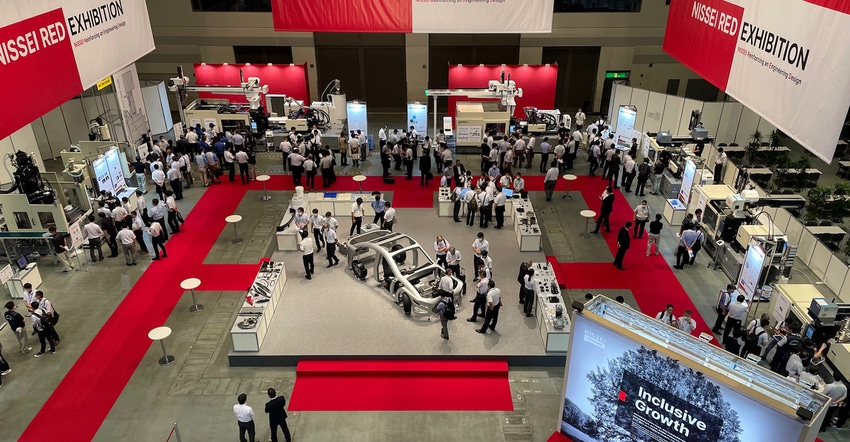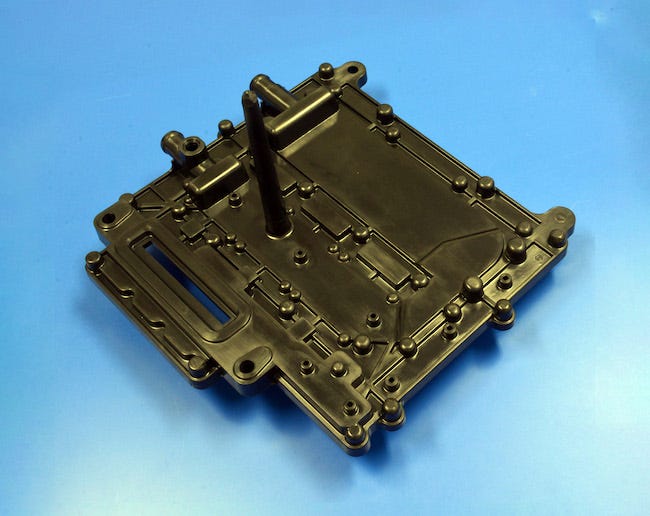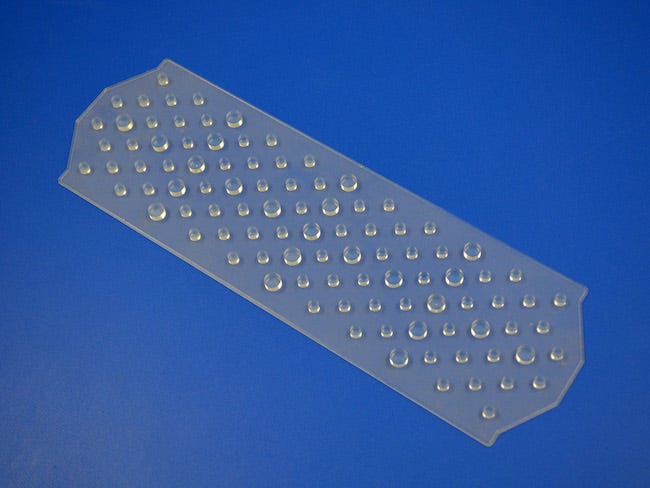Thermoset Resins Set to Play Key Roles in Vehicle Lightweighting
Injection machine builder Nissei Plastic teams up with materials supplier Sumitomo Bakelite to expand adoption of EV components molded from phenolic and epoxy resins.
August 11, 2023

Long perceived to be in decline, thermoset resin molding is being revived by two Japanese companies as a process with ample potential to contribute to lightweighting in electric vehicles (EVs). Injection machine builder Nissei Plastic and development partner Sumitomo Bakelite, a supplier of thermoset resins, held an in-house event at the Nagoya Congress Center on Aug. 2 to 4, 2023, in Aichi Prefecture, showcasing multiple thermoset molding solutions and more to 230 companies from the automotive industry, including OEMs and tiers. Home to Toyota Motor and Honda plants, Aichi is considered the capital of automobile manufacturing in Japan.
|
Thermoset inverter covers are up to 50% lighter than their aluminum counterparts. |
Traditionally, thermoset injection molding has been utilized in Japan to mold relatively small components for the electrical sector, typically weighing in at 150 g or less. Nissei Plastic and Sumitomo Bakelite, however, have their sights set on components tipping the scales at 1 kg or more for applications such as e-axle invertor covers. Prototype parts molded on a Nissei FWX760III-130BK thermoset injection molding press using biomass-derived phenolic resin tip the scales at 1.4 kg but nevertheless are reportedly 50 to 70% lighter than conventional steel covers and 20 to 50% lighter than aluminum versions.
Optimized injection pressure
Speaking to PlasticsToday at the event in Japan, Nissei Plastic CEO Hozumi Yoda highlighted the fact that the “760” in the machine’s model name refers to the tie-bar clearance of 760 x 760 mm, rather than the clamping force of 3,540 kN (360 tons). “In general, we feel injection machines tend to be over-specified for the application at hand, with molders tending to ram the resin through the injection cylinder at high pressure and compensating for this with a higher clamping force in the case of thermoplastic molding,” he explained. “Our approach is to optimize injection pressure using our N-SAPLI low-pressure molding system and apply the minimal clamping force.”
The N-SAPLI control system can also be applied to thermoset molding to precisely control the flow of the liquid polymer into the mold, thereby raising the precision of the final part to a tolerance of 0.3 mm compared with the 0.7 mm typically achievable. “We are targeting a precision of 0.2 mm by applying N-SAPLI to the injection-compression molding of a thermoset resin,” added Yoda.
Less costly, more precise electronics encapsulation
Another area where Sumitomo Bakelite and Nissei Plastic are propelling innovation is in the encapsulation of circuit boards, which is conventionally carried out using the more costly and lower precision transfer molding process. Precision control of injection pressure at low levels is critical in this application to prevent damage to the circuit boards. “Typically, you need to limit injection pressure to less than 13 MPa and we have demonstrated on our FNX110III-18AK press that we can control pressure in the range of 6 to 10 MPa,” said Yoda.
LSR potential for battery cell spacers
A third thermoset resin in Nissei Plastic’s liquid silicone rubber (LSR) has potential for applications in battery cell spacers as well as high-voltage EV battery connectors that are water-resistant, to boot. The current material of choice for battery cell spacers, which compensate for cell expansion and contraction during charging and discharge, is EPDM rubber.
|
LSR Li-ion battery cell spacer also exhibits potential as a heat-resistant placemat. |
At its in-house event, Nissei Plastic exhibited the 180-tonne clamping force NEX180III-5ELM all-electric press outfitted with a dosing system from Elmet and its own spiral plunger system that combines the first-in/first-out benefits of an inline screw with the dosing accuracy of a plunger system.
Aware that someday in the future the emergence of solid-state batteries might transform the material requirements of EV drive systems, this writer suggested a potential alternative application for the battery cell spacers being molded in Nagoya. He duly accepted two samples to take back to his base in Singapore and currently uses them as heat-resistant placemats.
Editor’s note: Stephen Moore, the author of this article, is an external director of Nissei Plastic.
About the Author(s)
You May Also Like





